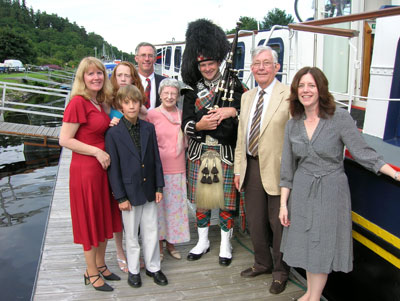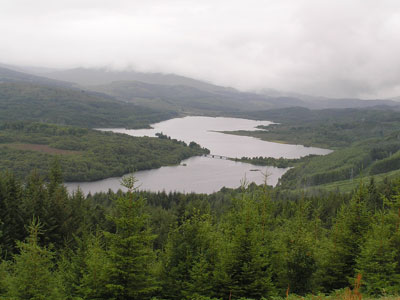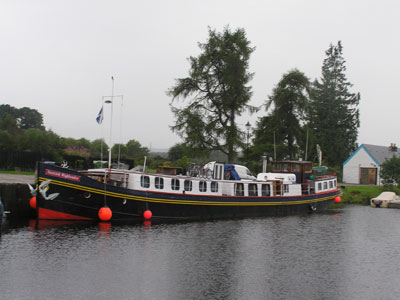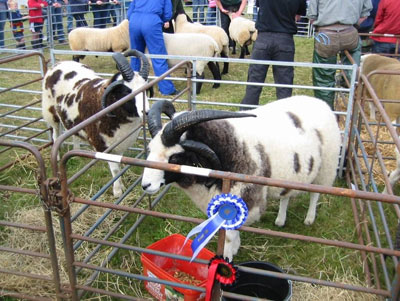Cruising Scotland's Caledonian Canal
by Art and Jean Thomas, Florham Park, NJ
2008 marked our 50th wedding anniversary, and we decided it would be a good year to celebrate with our family. Since we are longtime devotees of river cruising, we chartered a barge for our family of seven for a one-week trip in August ’08 through the Highlands of Scotland on the Caledonian Canal.
First impressions
So there we were: a pair of septuagenarians, three 40-somethings, a 13-year-old and a 10-year-old. Having flown from Newark to Glasgow, we were transported to Fort William by a charming driver, Harry Furay of Travel Confidential (Paisley, Scotland; phone +44 [0] 7828 113 233, www.travelconfidential.co.uk), at a cost of $200, being entertained by snippets of Scottish history on the way.
Since we were in Scotland, we were not surprised to find that it was raining, though the scenery still managed to be impressive.
We were delivered to the Lime Tree Hotel (phone 01397 701806, www.limetreefortwilliam.co.uk), where the children promptly curled up on couches and went to sleep while the rest of us enjoyed an excellent lunch in the dining room overlooking Loch Linnhe.
At midafternoon the barge captain, Dan, drove us to the village of Banavie, where we boarded the Scottish Highlander, an 8-passenger barge that would be our home for the next six days. The four bedrooms, each named after a Scottish clan (Cameron, Macpherson, Fraser and Macintosh) and decorated in the appropriate tartans, were well appointed, roomy and comfortable.
The common area — a combination parlor and dining room — offered a table seating eight, elegant leather-upholstered chairs and couches, and windows on both sides. A bookcase was well supplied with reading material and games. The bar, equally well supplied, was at our disposal. A coffee machine, a bowl of fresh fruit and a selection of cookies were available at all times, and dishes of candy tempted us in the bedrooms and the common area.
Champagne and hors d’oeuvres, including plenty of smoked salmon, welcomed us, preparing us for what would be a succession of exquisitely prepared and succulent dinners. Through the week, we dined on local specialties: lamb, beef filet, venison and broiled salmon — all delicious.
Lunches were eclectic, featuring many different types of salad, excellent soups (including that curiously named Cullen skink, found only in Scotland) and even some Asian and Mexican dishes, followed by a selection of local cheeses. Sticky toffee and bread-and-butter puddings were family favorites for dessert.
The chef cum first mate, Mark, had checked with the children on their likes and dislikes and regularly prepared special dinners and lunches for them, including spaghetti and even pizza. Kayleigh, the third member of the crew, served as waitress, sommelier (two wines were offered with both lunch and dinner) and steward.
Since no one had slept very much on the flight over, we opted for an early night. Waking the next morning, we greeted a beautiful day, bright sunshine gilding the water and sparkling on the slopes of the surrounding mountains, one of which was Ben Nevis, Scotland’s highest at more than 4,000 feet.
Touring the land
After the first of our full English breakfasts — porridge, eggs any style, bacon, sausage, fried tomatoes and mushrooms and cold cereals — we met the fourth member of our staff, Marus, known as Moshy, who would drive us in an 8-passenger van for the land excursions.
We drove through charming small villages and gorgeous countryside to Glencoe, a national park and wildlife preserve owned and operated by the National Trust of Scotland. Along with its natural beauty, Glencoe enters history as the site of the infamous massacre of Clan MacDonald members by their longtime foes, the Campbells. In 1692, under the pretext of a truce, the Campbells visited the Macdonalds and, after dining, turned on their hosts, slaying everyone in the clan under the age of 70.
The visitor center presented a film reenactment along with the recitation of a poem chronicling the massacre. The visitor center also presented the geologic and cultural history of the region, from its formation at the close of the Ice Age through its early years of Celtic settlement and up to the present.
We traveled on to the Ben Nevis Distillery. Established in 1825, it is one of the oldest of the many licensed distilleries in Scotland producing uisge beatha, “water of life.”
The visit began with a film, “The Legend of the Dew,” which recounted the legendary invention of Scotch whisky by a genial giant. This was followed by a guided tour that explained how Scotland’s most famous export is transformed from barley and water cooked over a peat fire into what many people consider ambrosia.
The guide informed us that the best way to savor whisky is with water to your taste, never ice. Naturally, a tasting followed.
On the canal
During the afternoon, we began our transit of the Caledonian Canal, which connects four lochs (Lochy, Oich, Ness and Dochfour) on the way from Fort William to Inverness, a distance of about 60 miles. Started in 1803 and completed 19 years later, the canal was built to provide a route between the Atlantic and the North Sea, bypassing the long and hazardous voyage around Cape Wrath.
Shortly after leaving Banavie, we entered our first lock, a fairly deep one leading into Loch Lochy. At our next port, Gairlochy, the five younger members of our party took advantage of the bicycles provided on the barge, and the two youngest later indulged in some (unsuccessful) fishing.
We were blessed with another glorious, sunshiny day, perfect for our planned trip up a mountain. On the way, we stopped at the village of Spean Bridge, where commandos trained for their hazardous duties in World War II. A monument outside the village commemorates those men, who represented many countries.
We also had some time to shop at Spean Bridge, where Scottish woolens, traditional foods and, naturally, whisky were offered.
From there we traveled on to Aonoch Mòr, a more-than-3,000-foot-high mountain that we ascended by gondola. It was an awe-inspiring journey. The gondola carried us above the trees, providing splendid views.
The view from the landing spot, about three-quarters of the way up the mountain, was truly spectacular: a verdant glen surrounded by impressive peaks, including Ben Nevis. Lakes glistened in the sunlight and the Great Glen spread out below.
As we leisurely cruised through lochs Lochy and Oich during the afternoon, the children had fun steering the barge under the watchful eye of Captain Dan. The older members of our group napped or relaxed on the small deck as the lovely countryside drifted by.
Loch Ness
The next day the rains came again. The barge moored at Fort Augustus above the 5-step lock that leads to Loch Ness. Scottish rains, like those in Ireland, can vary within minutes from torrential to gentle to mere mists. It was just a little more than a mist as we walked through the village and dropped in at the small museum devoted to the building of the Caledonian Canal.
The afternoon began with a long drive through the rain to Eilean Donan Castle. Along the way, Moshy made a stop on a bluff overlooking Loch Garry, whose shoreline appears to form a map of Scotland — a great place for photos.
Eilean Donan is positioned at the meeting point of three sea lochs. Although the site has been fortified for almost 800 years, the present building dates largely from the 20th century. It is privately owned but open to the public.
The setting, on the island of Donan, is spectacular, with wraparound views of the Highlands and the Isle of Skye visible to the west. It is one of Scotland’s most photographed castles.
Our crew had the evening off and dinner had been arranged for us at The Boathouse, a restaurant on the banks of Loch Ness. Thousands of rabbits cavorted on the grounds of what had been the original Fort Augustus. Converted to an abbey and later a private school, it is now being transformed into a hotel.
Farm fair
The rain had cleared the air, and the next day dawned bright and sunny. We started off with a cruise through five connected locks — from one end of Fort Augustus to the other — a distance of about 200 yards. Another long ride took us through mountains to the town of Beauly, where we were to attend the Black Isle Show 2008, an annual agricultural fair celebrating its 171st year. Dan had arranged this outing, since our visit coincided with the one day the fair was to be held.
We watched the judging of horses, ponies (led by little girls in full riding gear) and sheep being handled by youngsters between eight and 12 years old. We saw flower arrangements and fruits and vegetables, including onions the size of cabbages. Farmers in Wellington boots and tweed jackets were everywhere. Large, russet, hairy Highland cattle placidly chewed their cud as they waited to be judged.
The tent labeled Fur and Feathers was tremendously interesting. It featured rabbits twice the size of those we are familiar with plus a splendid variety of chickens, several looking as though they had been meticulously painted.
The children were delighted to partake of a carnival-type ride, perhaps compensation for being without television, Game Boys and text messaging for a week.
Leaving the fair, Moshy found us a roadside picnic table where we enjoyed the lunch which Mark had prepared for us that morning, complete with wine.
Castle stops
Our next stop was Castle Urquhart, situated on a rocky peninsula overlooking Loch Ness. Fortifications have stood there since the Iron Age. The ruins we visited dated from the 16th century.
An excellent film told the castle’s story, from its earliest incarnation to the 18th century. (It had been blown up by its last owners to prevent its being taken by the Jacobites.) The film ended with curtains being drawn back to give a panoramic view of the ruin.
While traveling to and from the fair the previous day, we had exclaimed many times at the beauty of the mountains covered with heather. The ever-attendant Moshy drove us up a slope called Suidhe, where we found ourselves surrounded by truly “purple mountain majesties” and looking down into crystal-clear tarns.
Back on the boat, we enjoyed another excellent dinner followed by an all-chocolate cake honoring our daughter’s birthday. (In our composite family journal of the trip, she pronounced this her “best birthday ever.”)
Friday morning dawned bright and sunny. We cruised through Loch Ness and photographed Castle Urquhart from the water.
We reached port at Dochgarroch, and Moshy transported us to Cawdor Castle, home to Angelika, The Dowager Countess Cawdor, who opens her elegant home to visitors while she’s on holiday for the summer. The castle was begun in 1454, evolving to the 17th century with many additions.
Descriptions of the rooms were written by the sixth Earl in a charming, witty style, including comments like “Mind your head, unless you’re a Papuan Pygmy” and “…portraits interesting rather than good.” The entire guidebook to the castle is written in this same chatty style; we recommend that anyone visiting buy and enjoy it. The extensive gardens were a delight to photograph.
Last night aboard
Next was the site of the Battle of Culloden, where the Jacobites, under “Bonnie Prince Charlie,” were defeated on April 16, 1746, by British forces led by the Duke of Cumberland, essentially ending the Stuart claim to the throne of Scotland.
A huge visitors’ center with interactive displays tells the history of the Jacobite rebellion in several languages (including Gaelic). Visitors enter a room surrounded by movie screens that put them in the midst of the battle, complete with severed limbs and general mayhem — an altogether impressive experience.
Our last night on the barge was highlighted by the Captain’s Dinner. We dressed accordingly and gathered on the pier to be serenaded by “Scotland’s finest piper,” who, our captain assured us, had been chosen by Madonna to perform at her wedding. Other boaters nearby also enjoyed the concert.
Dan joined us for dinner and we had the obligatory haggis, a very tasty one, plus filet of beef and bread-and-butter pudding. Another charming surprise was the presentation of a traditional wedding cake in honor of our 50th anniversary.
To cap off a lovely evening, the captain brought out his accordion and played Scottish songs for us. Mark and Kayleigh joined us as we said farewell to our wonderful crew.
Coming to a close
The next morning Dan chauffeured us to the railway station in Inverness. Our son, daughter-in-law and their children would be going on to Edinburgh to begin their second week of vacation, continuing down to London.
Our daughter and we went to Glasgow, where we were taken to Mar Hall Hotel (phone +44 [0] 141 812 9999, www.marhall.com) to spend the night before returning to the US. The hotel turned out to be a palatial edifice with vaulted ceilings and mullioned windows, oriental rugs decorating the parquet floors. Our rooms were large, well appointed and comfortable, and dinner was delicious — not a bad way to end what will stand as one of the best vacations of our lives.
The barge, operated by European Waterways (Middlesex, England; phone, in the US, 800/394-8630 or, in Canada, 888/342-1917, www.gobarging.com), was chartered through Abercrombie & Kent with the assistance of Destinations Travel of Vero Beach, Florida. The cost was $26,300 and included the crew, all meals and shore excursions. Tips for the crew as well as round-trip air from Newark to Glasgow were extra. The cost for two rooms at Mar Hall was £390 ($650).





